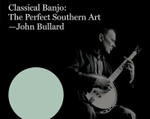|
Back
11/04/2016
“Classical Banjo: The Perfect Southern Art”
Robert Schumann (arr. J. Bullard): Three Romances for Oboe and Piano, Opus 94
Alessando Marcello (arr. J. Bullard): Concerto in D minor, S.Z799
Georg Philipp Telemann (arr. J. Bullard): Partita Nº 5 in E minor, TWV 41:e1
George Frideric Handel (arr. J. Bullard): Trio Sonata in G minor, Opus 2, Nº 8, HWV 393
Johann Sebastian Bach (arr. J. MacNelly): Fugue, Sonata Nº 1, BWV 1001 – Jesu, Joy of Man’s Desiring Movement Nº 10 from the Cantata “Herz un mund un tate und leben”, BWV 147
Edvard Grieg (arr. J. MacNelly): Waltz, Book 1, Opus 12 – Grandmother’s Minuet, Book IX, Opus 68 – Evening in the Mountains, Book IX, Opus 68 – In My Native Country, Book III, Opus 43 – Elves’ Dance, Book I, Opus 12 – Halling, Book IV, Opus 47
John Bullard (Banjo), Robert Kortgaard (Piano), Sylvain Bergeron (Archlute), Benjamin Stein (10 Curse, Renaissance Lute & Archlute), Joel Tangjerd (Baroque Cello), Valerie Gordon (Baroque Violin & Violin), Drew Jurecka, Rebekah Wolkstein, Aleksandar Gajie, Emily Hau, Eskender Bekmambetov, Jennifer Burford, Tamara Hrycak (Violin), Kathleen Kajioka, Carolyn Blackwell, Rory Mcleod (Viola), Rachel Mercer, Rachel Pomedli, Elspeth Poole (Cello), Joe Philipps (Bass), Jennifer Taverner, Erin Cooper-Gay (Soprano), Rebecca Claborn, Jessica Wright (Alto), Paul Ziadé, Nick Gough (Tenor), Graham Robinson, James Baldwin (Baritone)
Recording: Canterbury Music, Toronto, Canada (July 2015 and January 2016) – 65’
Bullard Music # JB100 – Booklet in English (Distributed by Buckleweet Media)

   
Think banjo and up pop images of a twangy steely instrument germinating from the rural countryside deeply nestled within the Appalachian Mountains. Those of us schooled in the South became enthralled with the sounds of optimistic melodies using rapidly dexterous plucking which we call “Bluegrass.” That’s where we pick up the story of John Bullard and his early banjo fascination with its distinctively wiry heavy metal shredding after hearing the legendary Dueling Banjos tune made famous by such artists as Flatt & Scruggs and even Deliverance’s Billy Redden with Ronnie Cox (on guitar.) But this presumed sound was a far cry from the direction Mr. Bullard wanted to take the banjo.
John Bullard has been magnetically drawn to Baroque and Renaissance music for over 30 years, and this is where he becomes an innovative artist moving “outside the box”: why not transform the five-string banjo into a classical instrument? It’s not to say that he hasn’t had resistance to this notion with various faculty members, but the Virginia native also had plenty of support from his contemporaries which eventually landed him the honors as being the first classical banjoist to graduate from Virginia Commonwealth University’s Department of Music.
What we hear on this CD will amaze and dispel the myth that this instrument is completely aligned with jocular jollity. A great percentage of these compositions were arranged by John Bullard and his associate, Jocko MacNelly, which lend a certain warmth and understated sincerity.
Upon the first turned leaf we find Schumann’s Three Romances, instantaneously wheeling its sign of cafard with restrained gravitas: Mr. Bullard’s air wafts like a cross between a mandolin and harpsichord…a far cry from Schumann’s originally intended oboe, but the novelty is refreshing, dishing up “food for thought.”
It has been cited that “musically speaking, John Bullard is the great grandson of Andrés Segovia.” Segovia cradled his guitar, bonding mother and child in intimacy. Similarly, Mr. Bullard carries forward that intent by caressing and melting notes into gossamer reverie. An impeccable discipline journeys inside the album with superb cut-to-the-edge grace notes.
John Bullard evokes an imagery with deliberate delicacy which is most apparent within œuvres by Telemann, Handel and Bach. Likewise, subtle twists can be made through the fingers on the frets in order to color each of the composers’ original production. A case in point can be found inside Grieg’s Lyric Pieces: the textures achieved are varied and well grounded. There’s an aura of contemplative richness, especially when adding strings’ accompagnato. Mr. Bullard has a way of convincing each nook and cranny with a dash of élégance respectueuse.
As exceptionally brilliant as it is masterful, “The Perfect Southern Art” enacts a heartfelt decree, opening up classical music to a world not yet discovered. A novel revelation.
Christie Grimstad
|